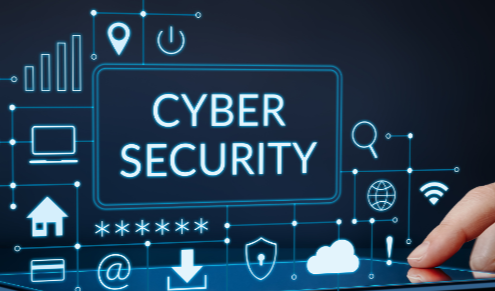Cybersecurity in The Spotlight: Safeguarding Your Business in the Digital Realm

In today’s digital world, the significance of cybersecurity cannot be understated. As businesses increasingly rely on technology, they’re becoming more vulnerable to cyber threats. In this article, we’ll dive into why cybersecurity is a must-have for modern businesses and how you can protect your digital realm effectively.
What is Cybersecurity?
Cybersecurity encompasses measures to protect computers, networks, and data from unauthorized access, damage, or theft. For businesses, it’s not just about keeping sensitive information secure; it’s also about maintaining the trust of customers and partners.
The Importance of Cybersecurity for Businesses
Cyber threats can harm businesses in various ways—from financial loss to reputational damage. A strong cybersecurity strategy is essential for safeguarding your assets and ensuring the continuity of your operations.
How Businesses are Vulnerable in the Digital Realm
Digitalization has opened up countless opportunities for businesses, but it has also created vulnerabilities. Cybercriminals exploit these weaknesses to steal data, disrupt operations, or demand ransoms. Being aware of these threats is the first step in safeguarding your business.
Cyber Threats and Their Impact on Businesses
Some common cyber threats include phishing, ransomware, malware, and denial-of-service attacks. These threats can lead to data breaches, financial losses, and loss of customer trust. Addressing these threats proactively is crucial for business success.
The Role of Data Engineering in Cybersecurity
Data engineering plays a pivotal role in strengthening cybersecurity. By processing and analyzing data, businesses can identify patterns of potential attacks and take preventive measures. Data engineering solutions help create robust security protocols and facilitate efficient incident response.
Further Strengthening Your Cybersecurity Strategy
To build a strong cybersecurity strategy, consider leveraging a combination of tried-and-true methods and innovative technologies. Conduct regular risk assessments to identify potential vulnerabilities in your systems and take immediate action to address them. Staying ahead of emerging cyber threats requires continuous learning and adaptation, which can be achieved through participation in industry forums and partnerships with cybersecurity experts.
Cybersecurity Training for Employees
Your employees are on the front lines of cybersecurity, and educating them is crucial for a robust defense. Offer training programs to keep your staff informed about common cyber threats and best practices for data handling. Encourage them to report suspicious activity and reward them for following security protocols, as this fosters a culture of vigilance and responsibility.
Leveraging Cybersecurity Insurance
While no defense is completely foolproof, cybersecurity insurance provides an additional layer of protection for your business. This insurance can cover financial losses and legal expenses in the event of a cyberattack. Consider investing in a comprehensive cybersecurity insurance policy to safeguard your company against unforeseen incidents.
Enhancing Cybersecurity for Remote Workers
With the rise of remote work, businesses must address cybersecurity challenges that come with offsite operations. Encourage remote workers to use secure VPNs, keep their devices updated, and avoid using public Wi-Fi networks for work. Providing them with clear guidelines and training will help minimize risks associated with remote work.
Maintaining a Proactive Stance
In the world of cybersecurity, being proactive is always better than being reactive. By constantly updating your security measures and staying informed about the latest threats and trends, you can protect your business from cyberattacks and ensure its long-term success. Remember, cybersecurity is an ongoing journey that requires vigilance and continuous improvement.
Key Aspects of Data Engineering Solutions for Businesses
- Data Management: Efficiently storing, processing, and securing data is essential.
- Analytics: Leveraging data to detect unusual patterns or anomalies.
- Automation: Automating threat detection and response processes.
The Significance of Secure Networks for Blogging
Blogging is a powerful tool for businesses to engage with their audience, but it also opens up potential security risks. A secure network for blogging ensures your content and data are protected against cyber threats. This is essential for maintaining the integrity of your online presence.
How Businesses Can Safeguard Their Networks
- Encryption: Encrypting data during transmission and storage adds a layer of protection.
- Firewalls: Implementing firewalls helps block unauthorized access to your network.
- Network Monitoring: Continuously monitoring network traffic can help detect anomalies.
Best Practices for Cybersecurity
- Strong Passwords and Authentication: Use complex passwords and multi-factor authentication.
- Software Updates: Regularly update software and systems to patch vulnerabilities.
- Employee Education: Train employees on best practices to minimize human error.
Cybersecurity Tools and Technologies
There’s an array of tools and technologies available to help secure your business:
Antivirus and Anti-malware: Protects against various forms of malware.
Intrusion Detection Systems: Monitors network traffic for suspicious activity.
AI and Machine Learning: Advanced solutions for identifying and mitigating threats.
Read more Search Engine Marketing Algorithm Updates to Expect in 2024
Importance of Data Privacy for Businesses
Data privacy is vital for maintaining customer trust and complying with legal regulations. Businesses must prioritize the ethical handling of customer data and ensure that they’re transparent about data usage.
Legal and Ethical Considerations
Compliance: Adhering to data protection laws such as GDPR or CCPA is essential.
Transparency: Communicate data practices to customers.
Ethical Responsibility: Handle data with respect and integrity.
Steps for Creating an Incident Response Plan
Preparation: Establish roles, responsibilities, and communication plans.
Detection: Implement monitoring systems to identify incidents.
Containment: Isolate affected systems to prevent spread.
Eradication: Remove threats and restore systems.
Recovery: Return to normal operations and review incident response.
How Businesses Can Prepare for Cyberattacks
Being proactive is key to minimizing the impact of cyberattacks. Regularly backup data, conduct security audits and simulate cyberattack scenarios to strengthen your defenses.
Current and Emerging Trends in Cybersecurity
Zero Trust Architecture: Restricting access based on need and verification.
Cloud Security: As businesses move to the cloud, securing it becomes paramount.
IoT Security: Protecting connected devices from cyber threats.
Impact of Trends on Businesses
Staying ahead of cybersecurity trends allows businesses to adapt and strengthen their defenses. Being aware of the latest advancements helps businesses implement the most effective strategies.
Conclusion
Cybersecurity is not just an IT concern; it’s a critical aspect of every business’s success. By understanding the risks and implementing robust defenses, you can protect your business in the digital realm. Prioritize cybersecurity to safeguard your data, operations, and reputation.
FAQs
What is the role of data engineering in cybersecurity?
Data engineering involves processing and analyzing data to identify patterns of potential attacks, which helps in creating robust security protocols and efficient incident response.
How can businesses safeguard their blogging networks?
Businesses can use encryption, firewalls, and network monitoring to secure their blogging networks and protect against cyber threats.
Why is data privacy important for businesses?
Data privacy maintains customer trust and ensures compliance with legal regulations. Transparent and ethical data handling is crucial for business success.
What are the best practices for cybersecurity?
Best practices include using strong passwords and authentication, regularly updating software, and educating employees on cybersecurity.
What are some current trends in cybersecurity?
Current trends include zero trust architecture, cloud security, and IoT security. Staying updated on these trends helps businesses stay protected.




